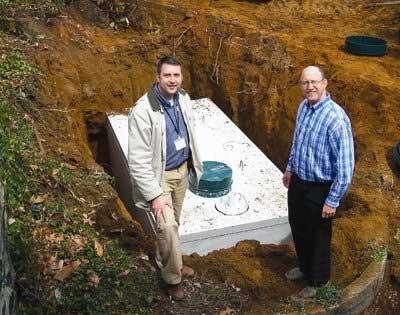Anne Arundel County has a grant to locally administer the Bay Restoration Fund (BRF) program. The BRF is a State-supported program that provides funding to replace conventional septic tanks with nitrogen-reducing units or funding for sewer connections of existing dwellings where public sewer is available. The program’s purpose is to reduce the amount of harmful nutrients, such as nitrogen, that septic systems discharge into the Chesapeake Bay and its tributaries.
Prioritization of BRF Grant Funds
Priority Level | Description |
| 1. | Failing septic systems in the Critical Area* |
| 2. | Failing septic systems outside the Critical Area |
| 3. | Septic systems for which there is no County permit record or for non-conventional systems in the Critical Area |
| 4. | Septic systems for which there is no County permit record or for non-conventional systems outside the Critical Area |
| 5. | Permitted conventional septic systems in the Critical Area |
| 6. | Permitted conventional septic systems outside the Critical Area |
*The Chesapeake Bay Critical Area is all land within 1,000 feet of the high water line of tidal waters of the Chesapeake Bay and its tributaries. For more information about the Chesapeake Bay Critical Area, visit dnr.maryland.gov/criticalarea/Pages/default.aspx.
Septic Systems: For step-by-step instructions on securing funds for a nitrogen-reducing pretreatment unit, see: Septic Systems: New, Upgrades and Repairs
Property owners with failing septic systems must prevent system overflow by following these guidelines: Septic System: Collapsed Septic Tanks, Overflowing and Failing Septic Systems Interim Health and Safety Requirements.
Public Sewer Connections: The Bay Restoration Fund Program has been expanded to include sewer connections of existing dwellings currently served by a septic system where public sewer is available and immediately borders a property. For step-by-step instructions, see Sewer Connections: Existing Dwellings Where Public Sewer Is Available.
Other Useful Links:
How much BRF assistance is available?
The Maryland Department of the Environment has established a Maximum Allowable Cost for each of the field-tested BAT nitrogen-reducing units. Homeowners with combined incomes up to $300,000 per year and nonprofit entities are eligible for 100 percent of the Maximum Allowable Cost, except for new construction projects on previously vacant lots where the maximum grant will be reduced by $1,200. Homeowners with combined incomes of more than $300,000 per year and large business entities are eligible for grants reduced by 50 percent. Business entities that meet the definition of “Small Business” in COMAR 21.01.02.01 may qualify for 75 percent funding. The property owner is responsible for the County perc application fee ($450), the nitrogen-reducing unit installation permit fee ($625) and any other septic system work beyond the nitrogen-reducing unit. If no contractor is willing to install any of the field-tested units for the Maximum Allowable Grant amount, the homeowner will be expected to pay the cost difference.
Families with low or moderate incomes can apply for additional assistance to help with drainfield, dry well and other septic system replacement and repair costs. See Well and Septic System Assistance.
What future building improvements can be considered for my property?
Any future building improvements or additions must comply with applicable State and local regulations, the Master Plan for Water Supply and Sewerage Systems, the Private Sewage Disposal Code, and all connected rules and regulations.
Building or property improvements that increase the habitable area or living space of a dwelling must comply with the requirements of the Private Sewage Disposal Code. The existing septic system will be evaluated based on its adequacy in handling the proposed increase in living space. In most cases, area for two future replacement systems must be identified on the property before building permit approval can be made. If the existing septic system is determined to be inadequate to serve the increase in living area, then a nitrogen-reducing BAT unit will be required, whether the property is in the Critical Area or not.
If the property does not meet the conventional requirements of the Private Sewage Disposal Code and the existing septic system is found to function properly, a property may qualify for a one-time limited home addition. The limited home addition allows a home expansion of up to a 50 percent increase in the living space of an existing dwelling, with a maximum increase of 1,000 square feet and no increase in the number of bedrooms.
Property improvements, such as swimming pools, sheds, garages, decks, patios and porches, are approvable provided that the minimum setback requirements are met. The minimum setback requirements can be found at Distance Requirements and Private Sewage Disposal Code.
Maryland regulations require nitrogen-reducing units that are approved as Best Available Technology (BAT) for all new and replacement septic systems in the Critical Area. The property owner shall maintain and operate all new and existing BAT systems for the life of the system through the use of a certified service provider. The owner shall ensure the BAT system is inspected and has necessary operation and maintenance performed at a minimum of once per year.
How can I request a presentation about this grant opportunity?
Department of Health staff members are available to meet with homeowner associations, community leaders and community interest groups to present information about the Bay Restoration Fund. To schedule a presentation, call the Department of Health at 410-222-7324.
For More Information, Contact:
Sanitary Engineering Program
Bureau of Environmental Health
Anne Arundel County Department of Health
3 Harry S. Truman Parkway
Annapolis, Maryland 21401
410-222-7193

